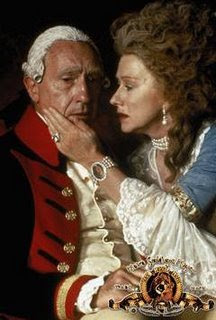The Madness of King George focuses on the deteriorating mental health of King George III of England during particularly at a period around Regency Crisis of 1788. The illness starts to show itself by discoloured urine, cramps, abdominal pain and soon enough, by a mental disorder that would officially label the king as "mad". Several medical actions take place, while in the background we witness parts of the Regency Crisis. He is finally taken away from the palace to a house in the country where he is cured by the unusual methods of Dr. Willis; he believes that the key to the cure lies in the behavioural discipline and he applies this strict disciplinary restrictions to the king, dismissing mostly the other physical symptoms. George III finally recovers and gets back his power, with a happy ending to the movie.

Today, it is known that King George III of England, in fact, had suffered from porphyria, a genetic disorder. It is very unlikely for men to show the symptoms of the illness, and George himself did not show any until the age of 50. A recent research made in 2003, by Professor Martin Warren, by the samples taken from the king's hair exhibited in a London museum showed that he was exposed to large amounts of arsenic, probably from the powders used in wigs and later on some medications applied by several doctors of the time, and this was the main substance that triggered the illness. Today, porphyria is still incurable, though several drugs are used to decrease the amount and severity of the symptomatic attacks. George III too had not recovered totally and had the attacks again in 1811, this time until his death. The movie therefore shows only the first period of his illness.


The Madness of King George is a 1994 movie by Nicholas Hytner and is an adaptation from Alan Bennett's play The Madness of King George III. The cast is a hall of fame; the ever brilliant Nigel Hawthorne as King George, the amazing Helen Mirren as Queen Charlotte, accompanied by Ian Holm as Dr. Willis, Rupert Everett as Prince of Wales, Julian Wadham as Pitt and John Wood as Thurlow. It is a great period movie, with several themes. In the center, it focuses on the relatively primitive medical actions of the time. While the Royal doctors have no positive result by their medications, probably because of the arsenic as we discover today, Dr. Willis seem to have some kind of a response, probably thanks to taking away the large amount of arsenic involved substances. Until that time, the king had never been told what to do, as he had the ultimate power, however, the change was about to come. This strict discipline the king is exposed to is also a link to this change, or shift, of the powers between royalty and the parliament, which is the other theme in the movie, and the time. Therefore, in the end, the recovered king tells his family, and mostly to his son, the Prince of Wales, that they are paid to wave the crowd and to seem happy, as a model of well behaviour to the people; it is the time of modern constitutional monarchy.

With severals awards and nominations in the Academy Awards, BAFTA Awards and Cannes Film Festival, the Madness of King George is an officially good movie, deserving all those awards and probably even more. For the audience, it is a great experience to witness a part of British history, mixed well with humour and drama, and to witness the amazing acting by Nigel Hawthorne, Helen Mirren and Ian Holm.




No comments:
Post a Comment